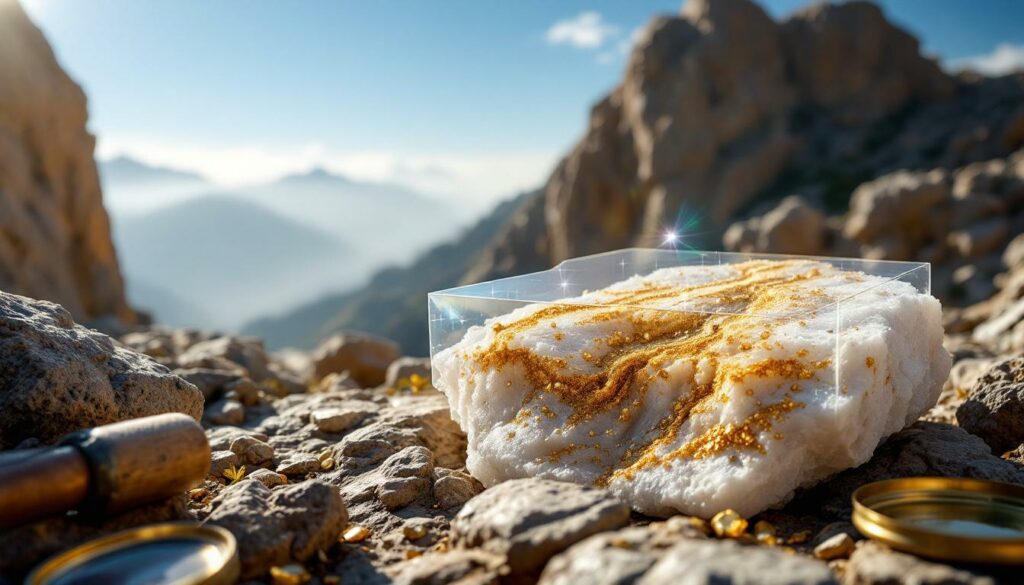What Are Gold-Bearing Quartz Veins?
Gold-bearing quartz veins represent one of nature's most fascinating geological formations, where precious gold becomes trapped within white to milky-colored quartz structures. These veins form some of the world's richest gold deposits and have been mined for centuries across every continent. Understanding these remarkable formations is the first step toward successful prospecting for anyone wanting to learn how to find gold in quartz veins.
The Science Behind Gold-Quartz Formation
Gold-quartz veins form through complex hydrothermal processes that occur deep within the Earth's crust. These remarkable structures develop when mineral-rich, superheated fluids move through cracks and fissures in rock formations, eventually depositing both silica (quartz) and precious metals like gold.
The formation process typically unfolds at specific temperature and pressure conditions. According to research published in Economic Geology, these veins predominantly form in upper crustal brittle-ductile transition zones at temperatures between 250-400°C (Dr. Richard Goldfarb, USGS). The pressure conditions typically range from 1-5 kilobars during vein formation, equivalent to depths of approximately 3-15 kilometers beneath the Earth's surface.
Gold precipitation within these quartz matrices occurs through several mechanisms:
- Cooling of hydrothermal fluids: As hot fluids cool, their ability to hold dissolved gold decreases
- Pressure changes: Sudden drops in pressure can force gold out of solution
- Chemical reactions: Particularly sulfidation or boiling of fluids
- Mixing of different fluid types: Creating chemical conditions favorable for gold deposition
These processes require extraordinary timeframes to produce significant gold concentrations. The most productive gold-quartz vein systems in greenstone belts, such as the Abitibi Belt in Canada, formed 1.8-2.7 billion years ago during the Archaean period. This extended period allowed for the slow concentration of gold to economically viable levels through mineral exploration insights.
Common Characteristics of Gold-Bearing Quartz
Identifying gold-bearing quartz requires understanding the visual and structural characteristics that differentiate productive veins from barren ones. While not all gold-bearing quartz looks the same, certain features appear consistently across productive deposits worldwide.
Visual markers that often indicate gold-bearing potential include:
- Iron staining (reddish-brown to yellow coloration)
- Vugs or small cavities in the quartz
- Smoky or dark-banded appearance
- Fine-grained pyrite or other sulfide inclusions
- Network of tiny fractures or "ribboning"
"The presence of sulfide minerals, particularly pyrite and arsenopyrite, is perhaps the most reliable indicator of potential gold mineralization in quartz veins. These minerals appear in over 80% of orogenic gold deposits worldwide." – Groves et al., Ore Geology Reviews, 2018
Quartz veins exhibit several distinct structural patterns, each with different gold-bearing potential:
- Ribbon veins: Characterised by parallel layers or bands of quartz, often with dark mineral inclusions between bands
- Stockwork veins: Networks of small, interconnected veins creating a web-like pattern
- Breccia veins: Angular rock fragments cemented together by quartz
- Massive veins: Solid, homogeneous quartz bodies with fewer visible structures
The presence of certain "indicator minerals" significantly increases the likelihood of gold. These companion minerals include:
| Mineral | Appearance | Relationship to Gold |
|---|---|---|
| Pyrite | Brassy yellow cubes | Most common gold associate |
| Arsenopyrite | Silver-white, metallic | Strong indicator in many deposits |
| Galena | Lead-gray, cubic, heavy | Common in gold-bearing systems |
| Chalcopyrite | Brassy with rainbow tarnish | Indicates mineralised system |
| Sphalerite | Black to brown resinous | Associated with polymetallic gold |
The Hollinger Mine in Canada represents a classic example, having produced over 30 million ounces of gold from quartz-carbonate veins averaging 8g/t gold content (Ontario Geological Survey, 1991).
Where Should You Look for Gold-Bearing Quartz?
Finding gold-bearing quartz requires understanding the geological settings where these precious veins are most likely to form. With this knowledge, prospectors can focus their efforts on high-potential areas rather than searching randomly.
Prime Geological Settings
The most productive gold-quartz vein systems typically form along specific geological features that create the necessary conditions for mineralisation.
Ancient tectonic boundaries represent prime hunting grounds for gold-bearing quartz. These zones of crustal weakness provide pathways for gold-bearing fluids to migrate upward from deep within the Earth. The best examples include:
- Subduction zone margins (like the Pacific Ring of Fire)
- Continental collision zones (like the Appalachian Mountains)
- Major fault systems (like California's San Andreas Fault)
"Fault jogs and dilatant fractures create ideal quartz vein deposition sites by forming low-pressure zones that allow mineral-rich fluids to precipitate gold and quartz." – Dr. Stephen Cox, Australian National University (Journal of Structural Geology, 1985)
Greenstone belts stand out as extraordinary gold hosts. These ancient volcanic and sedimentary rock formations, typically 2.5-3.8 billion years old, contain approximately 30% of the world's known gold reserves (Frimmel et al., Earth-Science Reviews, 2020). Famous examples include:
- Abitibi Greenstone Belt (Canada)
- Yilgarn Craton (Australia)
- Barberton Greenstone Belt (South Africa)
Research shows that structural traps like fault intersections increase mineralisation probability by up to 4 times (Micklethwaite et al., Tectonophysics, 2015). Look specifically for:
- Areas where different rock types meet (geological contacts)
- Places where faults intersect or change direction
- Folds in rock layers, especially at their hinges
- Zones where older rocks have been intruded by younger igneous bodies
Exposed bedrock areas with visible quartz outcroppings provide direct access to potential gold-bearing structures. The best exposures typically occur:
- Along stream cuts and riverbanks
- On recently eroded hillsides
- In road cuts and construction sites
- Around tree throw areas where roots have upturned soil
- In regions with minimal soil development
Global Hotspots for Gold-Quartz Veins
Productive gold-quartz regions exist on every continent, with certain areas gaining legendary status among prospectors. Despite their geographic distance, these regions share remarkable geological similarities that become apparent through gold deposits analysis.
Notable gold-quartz regions include:
North America:
- California Mother Lode (40+ major veins over 190km strike length)
- Colorado Mineral Belt
- Nova Scotia Gold Districts
- Alaska-Juneau Gold Belt
Australia:
- Victorian Goldfields (produced over 2,500 tons of gold from quartz reefs)
- Palmer River, Queensland
- Kalgoorlie Region, Western Australia
Africa:
- Barberton, South Africa
- Ashanti Belt, Ghana
- Zimbabwe Greenstone Belts
South America:
- Veladero District, Argentina
- Serra Pelada, Brazil
- Antioquia Department, Colombia
Asia:
- Kolar Gold Fields, India
- Central Asian Orogenic Belt
- Eastern China Gold Province
Accessibility factors vary dramatically between regions. When evaluating prospecting locations, consider:
- Legal access (claim status, public lands, permission requirements)
- Physical accessibility (roads, trails, terrain difficulty)
- Seasonal limitations (snow cover, monsoon seasons, fire danger)
- Equipment transportation challenges
- Proximity to services and supplies
How Can You Identify Gold in Quartz?
The ability to identify gold within quartz samples represents perhaps the most crucial skill for any serious prospector. While professional assays provide definitive answers, field identification techniques allow for immediate assessment and decision-making.
Visual Identification Techniques
Gold has distinctive physical properties that help distinguish it from common look-alikes. However, studies show that less than 5% of economically viable gold deposits contain macroscopic visible gold (Poulsen et al., GSC Bulletin, 2000), making identification challenging but not impossible.
When examining quartz samples, look for these gold characteristics:
- Colour: True gold displays a distinctive yellow to brassy-yellow colour that doesn't tarnish
- Lustre: Metallic and reflective, especially when scratched
- Malleability: Gold can be indented with a sharp tool while pyrite will shatter
- Distribution: Often appears along fractures or crystal boundaries within the quartz
- Form: May appear as specks, flakes, wires, or crystalline structures
Distinguishing gold from pyrite ("fool's gold"):
| Characteristic | Gold | Pyrite |
|---|---|---|
| Colour | Rich yellow | Pale brassy yellow |
| Streak colour | Yellow | Black/greenish |
| Crystal form | Irregular, rounded | Cubic or striated |
| Hardness | Soft (2.5-3) | Hard (6-6.5) |
| Malleability | Bends/dents | Brittle, breaks |
| Specific gravity | Very heavy (19.3) | Moderately heavy (5.0) |
Oxidation patterns provide valuable clues about gold potential. Iron staining (reddish-brown to yellow coloration) often indicates the weathering of sulfide minerals that commonly accompany gold. This staining creates what prospectors call "gossan" or iron hat formations.
"Iron oxide staining results from the breakdown of pyrite and other sulfides, which are commonly associated with gold mineralisation. These rust-colored zones serve as visual markers that warrant closer examination." – Johnston et al., Economic Geology, 1996
Alteration halos surrounding quartz veins can reveal important information about potential gold content. These zones where the host rock has been chemically changed by hydrothermal fluids often display:
- Silicification (rock becomes harder and more silica-rich)
- Sericitisation (development of fine-grained white mica)
- Chloritisation (rock develops greenish coloration)
- Carbonatisation (rock becomes reactive to weak acid)
- Sulfidation (development of sulfide minerals)
Field Testing Methods
Several practical field techniques can help determine if quartz samples contain gold. These methods range from simple mechanical tests to more sophisticated approaches requiring specialised equipment.
Crushing and panning technique:
- Break quartz samples into pea-sized fragments using a rock hammer
- Crush fragments to sand-sized particles using a mortar and pestle
- Place crushed material in a gold pan with water
- Swirl pan using circular motions to separate heavier materials
- Gradually tilt and wash lighter materials away
- Examine remaining heavy minerals for gold particles
Metal detector settings for quartz vein prospecting:
- Use specialised gold-hunting detectors (Fisher Gold Bug, Minelab GPX series)
- Select higher frequency settings (15-70 kHz) for smaller gold pieces
- Reduce sensitivity when working in mineralised ground
- Use smaller coils for better pinpointing in quartz veins
- Note that depth penetration is limited to approximately 15cm for small nuggets (Minelab Product Specifications, 2023)
Chemical tests can reveal invisible gold presence:
- Acid test: Gold remains unchanged in nitric acid while pyrite dissolves
- Mercury amalgamation: Gold bonds with mercury (hazardous, not recommended)
- Cyanide scratch test: Gold dissolves in sodium cyanide solution (hazardous, use with extreme caution)
UV fluorescence examination provides another investigative avenue. While gold itself doesn't fluoresce, certain associated minerals do:
- Calcite/dolomite halos predict gold in approximately 70% of cases (Rakovan et al., Rocks & Minerals, 2003)
- Scheelite (bright blue-white fluorescence) often accompanies gold
- Fluorite (purple, blue, or green fluorescence) can indicate hydrothermal activity
What Tools Do You Need for Quartz Vein Prospecting?
Successful quartz vein prospecting requires the right equipment. From basic hand tools to sophisticated electronic instruments, your gear choices will significantly impact your effectiveness and safety in the field.
Essential Field Equipment
Every prospector should assemble a core kit of reliable tools before venturing into the field. Quality matters—investing in durable equipment prevents failures at critical moments.
Geological hammers and sample collection tools:
- Rock hammer (16-22 oz with pointed tip for breaking rock)
- Cold chisel set (for extracting samples from veins)
- Hand lens (10x-20x magnification for mineral identification)
- Sample bags (heavy-duty plastic with write-on surfaces)
- Field notebook (waterproof pages with geological templates)
- GPS unit (3-meter accuracy recommended for claim staking)
Protective gear requirements:
- Safety glasses (ANSI Z87.1 rated for impact resistance)
- Leather or cut-resistant gloves
- Steel-toed boots (for protection from falling rocks)
- Hard hat (in areas with loose rock or overhanging material)
- Dust mask or respirator (when crushing or working with fine particles)
"Proper PPE isn't optional in the field—rock fragments can reach speeds exceeding 60 mph when struck with a geological hammer." – MSHA Safety Recommendation, 2023
Magnification tools provide crucial details invisible to the naked eye:
- Hand lens (10x for field use)
- Pocket microscope (30x-60x for detailed examination)
- Digital microscope (100x+ with photo capability for documentation)
GPS and mapping resources:
- Topographic maps (1:24,000 scale where available)
- Geological maps showing known mineralised zones
- Historical mining district maps
- GPS unit with waypoint marking capability
- Magnetic compass for taking strike and dip measurements
Advanced Detection Technology
As your prospecting activities grow more serious, advanced technologies can dramatically improve your success rate, though these come with significant investment costs.
Portable XRF analysers:
These handheld devices use X-ray fluorescence to identify elemental composition of rocks without damaging the sample.
- Cost range: $15,000-$40,000 (SciAps X-500 Product Brochure, 2024)
- Detection limits: 5-10 ppm for gold (marginal for many deposits)
- Analysis time: 30-60 seconds per sample
- Advantages: Non-destructive, immediate results, multiple element analysis
- Limitations: Surface analysis only, struggles with light elements, gold detection limitations
Ground penetrating radar (GPR) applications:
GPR systems can identify subsurface structures without excavation, helping map potential vein systems.
- Identifies veins >30cm thick at depths up to 20m (Liner et al., Geophysics, 2010)
- Shows best results in dry ground conditions (40% better penetration than wet conditions)
- Requires significant training for interpretation
- Portable systems start at $6,000+ for basic units
Laboratory testing considerations:
For definitive gold analysis, professional laboratory testing provides the most reliable results.
- Fire assay: The gold standard for precious metal analysis, detects gold to 0.01 ppm
- Atomic absorption: Useful for analysing dissolved gold in solution
- ICP-MS: Highly sensitive multi-element analysis capable of detecting gold at parts per billion
- Costs: $25-100 per sample depending on analysis method
- Turnaround time: Typically 1-4 weeks for results
How Do Professional Geologists Approach Quartz Vein Exploration?
Professional geologists apply systematic, methodical approaches to quartz vein exploration. Understanding these techniques can help prospectors of all experience levels improve their success rates dramatically through proper drilling results interpretation.
Systematic Sampling Strategies
Professionals rely on structured sampling programs that provide representative data about potential gold deposits. Random sampling rarely provides reliable information for decision-making.
Grid-based sampling methodologies:
- Reconnaissance phase: 5-25 samples per square kilometer (Sinclair et al., Exploration Geochemistry, 2017)
- Follow-up phase: Tightening grid to 100-200m spacing in promising areas
- Detailed phase: 25-50m grid spacing over target zones
This progressive approach focuses efforts on increasingly promising areas while maintaining systematic coverage.
Channel sampling techniques provide the most accurate grade estimation for exposed veins:
- Clean the sampling surface thoroughly
- Mark sample lines perpendicular to the vein structure
- Cut continuous 5cm-deep grooves across the entire vein width
- Collect all material from the channel, including wall rock contacts
- Document sample locations precisely with measurements and photographs
Wondering How to Identify the Next Major Gold Discovery?
Stay ahead of the market with Discovery Alert's proprietary Discovery IQ model, which instantly notifies investors of significant ASX mineral discoveries and transforms complex geological data into actionable investment insights. Explore historic returns from major discoveries and begin your 30-day free trial today at Discovery Alert's discoveries page.




